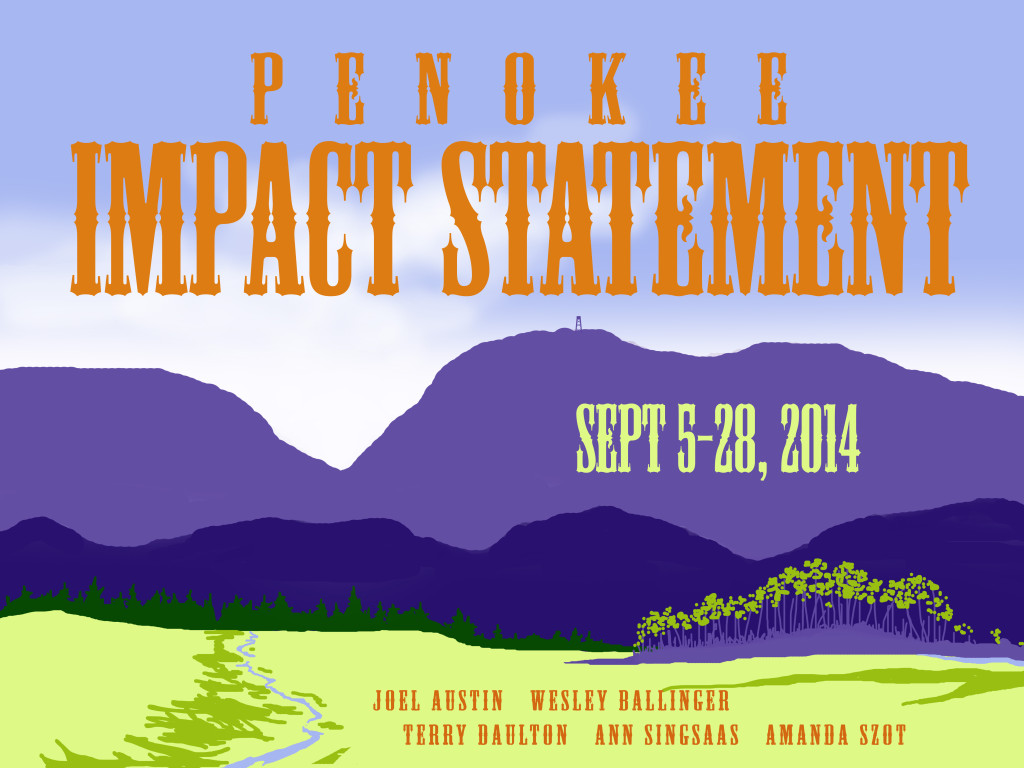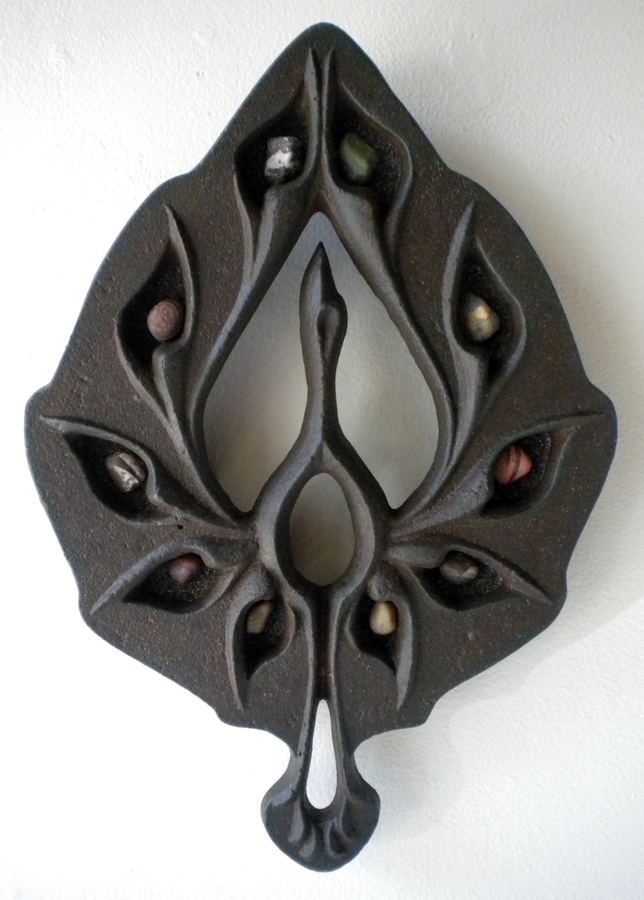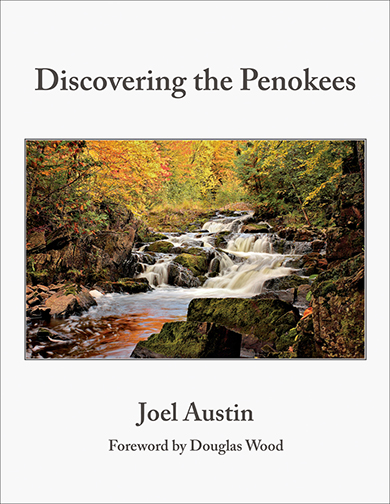“An Environmental Impact Statement is a tool for decision making, describing the positive and negative environments effects of a proposed action. Projects like the proposed Penokee open pit mine however, are driven by deeply held human values and emotional connections not included in an EIS. In this exhibit, five visual artists will share their interpretation of an Environmental Impact Statement for the Penokee Hills.”
Penokee Impact Statement
An Art Exhibition
Washburn Cultural Center
(Located just north of Ashland on the beautiful Chequamegon Bay)
September 5-28, 2014
Opening Reception September 5th, 5-7 PM,
Guest Speaker Bob Jauch
PARTICIPATING ARTISTS
Joel Austin – Terry Daulton – Ann Singsaas
Amanda Szot – Wesley Ballinger
Artists, in general, value and are drawn to places and expressions of beauty. It is not at all unusual for artists who live in Northern Wisconsin to be inspired by the beauty of the surrounding landscape, and to find its beauty and spirit making its way into their art. In Northern Wisconsin, GTAC intends to dig the world’s largest open-pit taconite mine—4.5 miles long, 1000 feet wide, and 900 feet deep for phase one—at the top of the Bad River watershed, which flows through the Bad River reservation and into Lake Superior. In this ecologically delicate area, a mine of this size is certain to alter the environmental wetlands, rivers, groundwater, and cultural heritage for generations to come. The artists in this exhibition use their art to ask us to reflect upon the values that drive decisions that will effect the waters, air, and lives of those who make their homes in the Penokee Hills watershed, and the rest of us who love and depend upon the health and beauty of the area, now and in the future.
Will the proposed Gogebic Taconite open pit iron mine in the Penokee Hills be a devastating example of mountain top removal, or a job creating modification to the landscape which enhances northwoods culture and protects the environment ?
This question is explored in the exhibit “Penokee Impact Statement”, which will be on display at the Washburn Cultural Center, September 5- 28. An opening is planned for Sept 5, from 5 pm – 7 pm. Special guest speaker will be retired Senator Bob Jauch, who was deeply involved in the mining issue during his time in the Wisconsin State Senate and has continued his work to protect northern Wisconsin interests since his retirement this past spring.
The five artists in the show have taken the concept of an environmental impact statement and worked to turn facts and scientific findings into imagery that captures the science, and the intangible values that are at stake if the Penokee Mine is permitted. In the show, they take an artist’s view of the formal government process in which the mining company creates an environmental impact report. The DNR uses that report as a basis for its environmental impact statement and eventual mining permit decision. At the opening, Bob Jauch will share comments on his work on the mining issue. The artists will be on hand to give perspectives on their work.
“Artists are able to capture not only facts, but feelings. Impacts from this mine include not just loss of wetlands and streams, but emotional losses relating to our sense of place and the wild character of our region”, says exhibit coordinator and artist, Terry Daulton.
Terry Daulton’s pastel paintings reflect her deep ties to the landscape and her background as an environmental educator. Daulton, a biologist by training, takes both a literal and aesthetic approach in her pastel paintings which portray wildlife, streams, wetlands, even the dark star filled sky; things which she believes will be impacted by this project. Daulton lives in Iron County and has been hiking in the Penokees for 3 decades.
Ann Singsaas is a painter and former field biologist. Her art work centers on natural elements using watercolor, oil on aluminum, or digital painting. Of this piece she writes:
“Some of the things of value: wild rice, boreal chorus frog, red maple, wood turtle, canadian yew, brook trout, winter wren, mayfly, yello birch. ad valorem (according to value) bonum commune communitias (for the common good of the community)
Ecosystem Service: treatment of waste, clean drinking water, pollination of food crops
Native Americans consider the effects of their decisions on future generations, they are investing wisely.”
Amanda Szot, sculptor and bead artist from Ironwood, Michigan, creates works from recycled iron, found objects and beads. Growing up in the aftermath of the last mining bust in Ironwood, she has a strong perspective on what values can be found in our region. She focuses not only on the Penokees, but also on Lake Superior and the Bad River Watershed.
“We live on a beautiful, abundant, nurturing planet. Yet, as human beings, we separate ourselves from the rest of nature by constructing dwellings with controlled environments and by taking more plants, animals, and minerals from the earth than we need to survive.
When I moved from the Milwaukee, WI area to Ironwood, MI in the early 1990’s, I fell in love with the landscape and Lake Superior, as well as the strange nostalgia associated with the mining history of Upper Michigan and northern Wisconsin. My artwork uses a visual language to communicate the human impact on our environment, showing how other living things have needed to adapt, as well as how we have sacrificed our health and happiness to acquire resources from nature. Consumption is necessary for everything to live, and hopefully our future use of the earth and its inhabitants will be more responsible than that of the past.”
Wesley Ballinger, Mille Lacs Band of Ojibwe, is an oil and watercolor painter. His work brings a Native American perspective using traditional storytelling to share views on how this mine could impact environment and tribal people. His works are mainly oil paintings with themes that represent our responsibility to care for the earth, the water and all the species that inhabit the earth. He is also an Ojibwe Language Specialist and graphic artist working at the Great Lakes Indian Fish and Wildlife Service in Ashland, and a children’s book illustrator.
Joel Austin is a photographer and writer. He has recently published the photo and essay book “Discovering the Penokees”. Proceeds from the book go toward work to protect the Penokee Hills watershed from the proposed GTAC mine.
His photographs, taken in the area of the proposed mine’s footprint or downstream, make a clear statement about the natural beauty and health of the existing Penokee ecosystem. “Mining, by definition, cannot create a truly sustainable-in-the-long-term economy. Beauty and an intact and healthy ecosystem can.” Joel aims to use his photographs to increase awareness of all that is slated to be lost if the open pit mine happens.
Sources for more information on the proposed Penokee Hills open pit mine:
The Lake Superior Binational Forum
Midwest Environmental Advocates
Penokee Hills Education Project of the Mining Impact Coalition of Wisconsin
Penokee Hills Information Directory: Protecting the Penokee Hills and Bad River Watershed of Northern Wisconsin
Wisconsin John Muir Chapter of the Sierra Club
Wisconsin Network for Peace and Justice
The Washburn Cultural Center is open Mon-Sat from 10 am – 4 pm. For more information on this show please contact: Terry Daulton, 715-476-3530 or the Washburn Cultural Center at 715-373-5591.





2 comments
Thank you for putting together this exhibition on perhaps one of the most serious issues facing us today.
It is important work to raise awareness of the situation with mining and politics and the consequences for the environment that sustains us.
Please let people know WHERE the Washburn Cultural Center is located. Not everyone knows where Washburn is, though if told it is just north of Ashland on the beautiful Chequamegon Bay, folks may be inspired to go see the show. … And spread the word.
I cannot take credit for putting this exhibition together. It was the work of the participating artists, but I am thrilled they are sharing their art and focusing on such an important issue. I’d love it if you would share this widely so their exhibit gets lots of attention.
Your email is used for verification purposes only, it will never be shared. By submitting a comment you grant Helen R. Klebesadel a perpetual license to reproduce your words and name/web site in attribution. Inappropriate and irrelevant comments will be removed at an admin’s discretion.